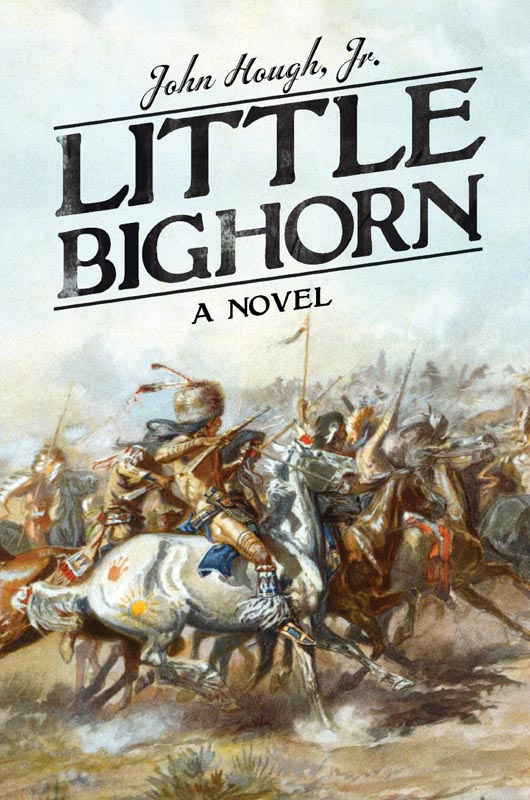Little Bighorn , John Hough Jr., Arcade Publishing, 320 pages, hardcover, sold in bookstores and online.
What does it take to propel a novelist onto the national stage? I’ve read Ward Just and Geraldine Brooks, perhaps the most celebrated Vineyard-based fiction writers, and I love their work. I believe my old friend John Hough Jr. of West Tisbury should occupy the same exalted status.
A journalist as well as novelist, Mr. Hough has used both skills in eight previous books of fiction and nonfiction on subjects ranging from baseball to the Civil War. His new book, Little Bighorn, mines history and imagination in considering Custer’s Last Stand.
The story begins with a scheme hatched by Custer and his mistress, the actress Mary Deschenes. They decide to pair a 16-year-old orphan named Addie Grace Lord with Deschenes’s 18-year-old son Allen Winslow on a train headed west. Addie Grace will escape her uncle, aunt and boarding school to see her brother George, a surgeon attached to Custer’s detail at Fort Lincoln. Eager to exile her son for a summer, Deschenes assigns Allen to be Custer’s “secretary.” The seemingly minor characters enrich and deepen the account beyond a war story.
They are extraordinary young people. Addie Grace comes to believe that suppressing the Indians “is evil work done by mortal men with some good in them, and I cannot wish them ill.” Allen, late of Phillips Exeter Academy, is a pacifist with enough gumption to debate Custer.
As we ride trains west with the kids, we discover that 19th-century passenger rail travel isn’t the glamorous ride we may have presupposed: “The washroom was lit by a smoking wall lamp that embittered the close and foul-smelling air. A public comb, brush and towel hung from tethers…”
In fact, the fetid smell of smoke runs through the whole train. Meanwhile, the couple falls in love, a relationship that carries our interest through the military disaster ahead.
They arrive at Fort Lincoln to meet a disparate band of soldiers, some “thieves,” “riffraff,” “foreigners” in the words of George Lord, other, more refined men constituting an ad hoc chorus singing Nearer My God to Thee. Custer’s wife Libbie is well drawn and sympathetic. “She was pretty rather than beautiful, but it was a presence that was beauty’s equal, more intricate in its components, more delicate, more perishable,” Mr. Hough writes. And, “Her bright eyes were constantly darting, seeking, as if nothing were too small or banal to interest or delight her.”
Called Son of the Morning Star by the Creek and Ree Indians who accompany his party, Custer is a complex character: loyal to his troops, tolerant enough to hear out his young charge, a teetotaler, an adulterer and a racist who still believes in slavery, but a commanding figure whose deep-set blue eyes and presence inspires his men. “The officers sat down and Custer stood to address them in his buckskin jacket and red cravat, folding his arms and canting a knee forward: theatrical, assertive, a stance elegant even to his enemies and perhaps especially to them,” Mr. Hough writes.
In the end, Custer is undone by his own achievements. In the Civil War, he rode directly at or parallel to the Confederates, daring them to shoot at him without suffering a scratch. At Gettysburg, General Robert E. Lee sent a considerable cavalry force behind Union lines to distract northern soldiers enough that Pickett’s Charge might succeed. With a much smaller contingent, Custer held the rebels at bay, helping to assure Pickett’s slaughter and the northern victory. So it was in character for him to dismiss reports of up to 3,000 Sioux opposing his exhausted delegation of fewer than 1,000 men at the Little Bighorn River. Fearing he’d be called a “poltroon” (coward) if the Indians escaped, Custer didn’t wait for available troops under two other generals to join him.
Custer faces Indian braves who are stronger, healthier and better fed than his soldiers. “Most of them were naked in breechclouts or leggings, their faces and bodies painted in lurid shades of vermillion, yellow, black, white, and to Allen they looked otherworldly, avatars of some bygone age of spectacle and sorcery.”
The battle scenes are gripping and gruesome enough to convince readers that all wars are disasters, even if they’re just and successful. We maintain our interest through the horrors, wondering if Allen will survive and reunite with Addie Grace back at Fort Lincoln.
Mr. Hough’s previous novel Seen the Glory, set on the Vineyard and at Gettysburg, cried out for a director to cast and shoot it. Among many films depicting Custer’s Last Stand, the most famous was probably the flawed They Died With Their Boots On (1941) starring Errol Flynn. Mr. Hough’s love story and military epic would make a much better movie.
What does it take to sell a book to Hollywood? Oh, never mind.
Jim Kaplan is the Gazette bridge columnist and author of 19 books, including three on American regions.








Comments
Comment policy »